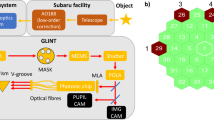Abstract
The European Space Agency’s infrared space interferometer DARWIN is dedicated to the investigation of Earth-like extrasolar planets orbiting bright stars. A multi-aperture interferometer fed by free-flying telescopes allows spectroscopic analysis of the weak planet signal which could give hints on the possibility of the existence of Earth-like life. However, for a Sun/Earth-like constellation at an interstellar distance of some 50 light years, a star light suppression of about 60 dB is required to make the weak planet signal visible. In this paper we investigate the nulling capability of a space-based Robin Laurance interferometer in the case of stochastic disturbances of the array geometry and of stochastic alignment errors of the optical components, which both will be actively controlled. Mismatch of amplitude transmission, optical path length, and polarization transmission among the interferometer arms is taken into account.
We numerically analyze Sun/Earth-like constellations in the wavelength range of 6 to 18 microns and calculate the expected value of the star light rejection ratio for the Robin Laurance geometry. It is shown that maximum standard deviations of only σp = 2 nm and σA = 5·10−1 for the differences in optical path length and amplitude transmission can be allowed to obtain a rejection ratio of R=60 dB. These and other exemplary numerical results confirm the extreme requirements for interferometer uniformity and give a quantitative insight into the dependence of the attainable rejection ratio on individual and/or combined interferometer imperfections.
Zusammenfassung
Das Infrarot-Weltraumteleskop DARWIN der Europäischen Weltraumbehörde ESA dient der Untersuchung erdähnlicher extrasolarer Planeten. Die Signale mehrerer freifliegender Teleskope werden in einem Interferometer auf geeignete Weise kombiniert, so dass das schwache Planetensignal spektroskopisch untersucht werden kann, um Hinweise auf erdähnliches Leben zu finden. Für eine Sonne/Erdeähnliche Konstellation in einer Entfernung von ungefähr 50 Lichtjahren muss jedoch das Sternenlicht um einen Faktor 106 unterdrückt werden, damit das Planetenlicht sichtbar wird.
Wir analysieren die Unterdrückungseigenschaft eines Robin Laurance-Interferometers für den Fall stochastischer Störungen der Gruppengeometrie und stochastischer Ausrichtungsfehler aktiv geregelter optischer Komponenten. Amplitudenfehler, ungleiche optische Pfadlängen und ungleiche Polarisations-eigenschaften der optischen Pfade werden berücksichtigt.
Wir untersuchen Sonne/Erde-ähnliche Konstellationen numerisch im Wellenlängenbereich von 6μm bis 18μm und berechnen den Erwartungswert der Unterdrückung des Sternenlichts. Wir zeigen, dass maximale Abweichungen von σp = 2 nm und σA = 5·10−1 für die Unterschiede in den optischen Pfadlängen und Amplitudentransmissionen erlaubt sind, um ein Unterdrückungs verhältnis von 60 dB zu erzielen. Diese und andere beispielhafte Ergebnisse bestätigen die Notwendigkeit eines extrem hohen Grades an Gleichheit der Interferometerarme und ermöglichen es, die Abhängigkeit des erreichbaren Unterdrückungs-verhätnisses von einzelnen oder kombinierten Fehlern abzuschätzen.
Similar content being viewed by others
References
Born, M., Wolf, E. (1999): Principles of optics. 7th ed. Cambridge: Cambridge University Press.
Bracewell, R. N., McPhie, R. H. (1979): Searching for nonsolar planets. ICARUS 38: 136–147.
European Space Agency (2001, Sept.): DARWIN project [Online], available: http://sci.esa.int/home/darwin/.
Karlson, A., Mennesson, B. (2000): The Robin Laurance nulling interferometers. Proc. SPIE 4006: 871–880.
Leger, A., et al. (1996): Could we search for primitive life on extrasolar planets in the near future? The DARWIN Project. ICARUS 123: 249–255.
Mennesson, B., Mariotti, J. M. (1997): Array configurations for a space infrared nulling interferometer dedicated to the search for earthlike extrasolar planets. CARUS 128: 202–212.
Wallner, O., Kudielka, K., Leeb, W. R. (2001): Nulling interferometry for spectroscopic investigation of exoplanets — a statistical analysis of imperfections. Proc. SPIE 4273: 47–55.
Author information
Authors and Affiliations
Corresponding author
Rights and permissions
About this article
Cite this article
Wallner, O., Kudielka, K. Performance analysis of a space-based multiple-telescope nulling interferometer for DARWIN. Elektrotech. Inftech. 119, 114–119 (2002). https://doi.org/10.1007/BF03161618
Issue Date:
DOI: https://doi.org/10.1007/BF03161618




